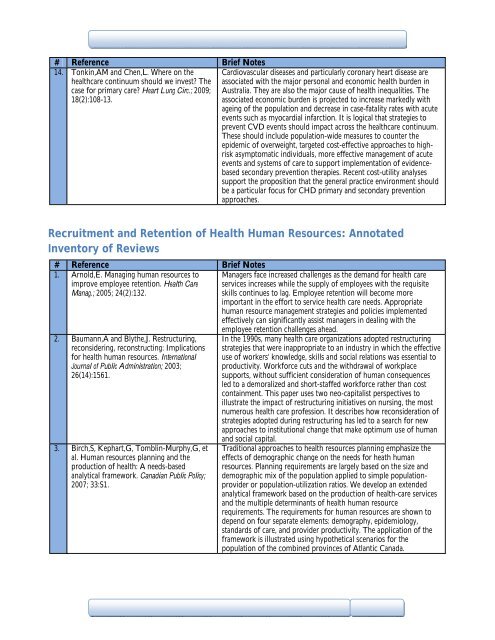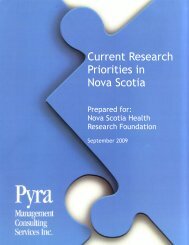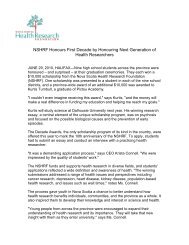Major Health Issues in Nova Scotia: An Environmental Scan
Major Health Issues in Nova Scotia: An Environmental Scan
Major Health Issues in Nova Scotia: An Environmental Scan
You also want an ePaper? Increase the reach of your titles
YUMPU automatically turns print PDFs into web optimized ePapers that Google loves.
# Reference Brief Notes<br />
14. Tonk<strong>in</strong>,AM and Chen,L. Where on the<br />
healthcare cont<strong>in</strong>uum should we <strong>in</strong>vest? The<br />
case for primary care? Heart Lung Circ.; 2009;<br />
18(2):108-13.<br />
Cardiovascular diseases and particularly coronary heart disease are<br />
associated with the major personal and economic health burden <strong>in</strong><br />
Australia. They are also the major cause of health <strong>in</strong>equalities. The<br />
associated economic burden is projected to <strong>in</strong>crease markedly with<br />
age<strong>in</strong>g of the population and decrease <strong>in</strong> case-fatality rates with acute<br />
events such as myocardial <strong>in</strong>farction. It is logical that strategies to<br />
prevent CVD events should impact across the healthcare cont<strong>in</strong>uum.<br />
These should <strong>in</strong>clude population-wide measures to counter the<br />
epidemic of overweight, targeted cost-effective approaches to highrisk<br />
asymptomatic <strong>in</strong>dividuals, more effective management of acute<br />
events and systems of care to support implementation of evidencebased<br />
secondary prevention therapies. Recent cost-utility analyses<br />
support the proposition that the general practice environment should<br />
be a particular focus for CHD primary and secondary prevention<br />
approaches.<br />
Recruitment and Retention of <strong>Health</strong> Human Resources: <strong>An</strong>notated<br />
Inventory of Reviews<br />
# Reference Brief Notes<br />
1. Arnold,E. Manag<strong>in</strong>g human resources to<br />
improve employee retention. <strong>Health</strong> Care<br />
Manag.; 2005; 24(2):132.<br />
Managers face <strong>in</strong>creased challenges as the demand for health care<br />
services <strong>in</strong>creases while the supply of employees with the requisite<br />
skills cont<strong>in</strong>ues to lag. Employee retention will become more<br />
important <strong>in</strong> the effort to service health care needs. Appropriate<br />
human resource management strategies and policies implemented<br />
effectively can significantly assist managers <strong>in</strong> deal<strong>in</strong>g with the<br />
2. Baumann,A and Blythe,J. Restructur<strong>in</strong>g,<br />
reconsider<strong>in</strong>g, reconstruct<strong>in</strong>g: Implications<br />
for health human resources. International<br />
Journal of Public Adm<strong>in</strong>istration; 2003;<br />
26(14):1561.<br />
3. Birch,S, Kephart,G, Tombl<strong>in</strong>-Murphy,G, et<br />
al. Human resources plann<strong>in</strong>g and the<br />
production of health: A needs-based<br />
analytical framework. Canadian Public Policy;<br />
2007; 33:S1.<br />
employee retention challenges ahead.<br />
In the 1990s, many health care organizations adopted restructur<strong>in</strong>g<br />
strategies that were <strong>in</strong>appropriate to an <strong>in</strong>dustry <strong>in</strong> which the effective<br />
use of workers' knowledge, skills and social relations was essential to<br />
productivity. Workforce cuts and the withdrawal of workplace<br />
supports, without sufficient consideration of human consequences<br />
led to a demoralized and short-staffed workforce rather than cost<br />
conta<strong>in</strong>ment. This paper uses two neo-capitalist perspectives to<br />
illustrate the impact of restructur<strong>in</strong>g <strong>in</strong>itiatives on nurs<strong>in</strong>g, the most<br />
numerous health care profession. It describes how reconsideration of<br />
strategies adopted dur<strong>in</strong>g restructur<strong>in</strong>g has led to a search for new<br />
approaches to <strong>in</strong>stitutional change that make optimum use of human<br />
and social capital.<br />
Traditional approaches to health resources plann<strong>in</strong>g emphasize the<br />
effects of demographic change on the needs for heath human<br />
resources. Plann<strong>in</strong>g requirements are largely based on the size and<br />
demographic mix of the population applied to simple populationprovider<br />
or population-utilization ratios. We develop an extended<br />
analytical framework based on the production of health-care services<br />
and the multiple determ<strong>in</strong>ants of health human resource<br />
requirements. The requirements for human resources are shown to<br />
depend on four separate elements: demography, epidemiology,<br />
standards of care, and provider productivity. The application of the<br />
framework is illustrated us<strong>in</strong>g hypothetical scenarios for the<br />
population of the comb<strong>in</strong>ed prov<strong>in</strong>ces of Atlantic Canada.











